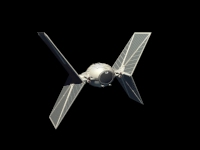
A limited number of these potent craft were bought by the Empire for the purpose of evaluation. While pilots who had been stuck with TIE/gt's and those assigned to ground bases loved them, but fighter pilots did not like it very much. Designed for optimized atmospheric performance against combat air speeders, cloud cars and low flying starfighters, it is as fast as and almost as nimble in atmosphere as the Interceptor, but this performance comes at the expense of space performance, hence the general dislike among pilots. With only 60% of the forward thrust in space as the TIE/ln, it was being outrun even by Y-Wings.
Using the basic ball from all of the TIEs, it retains the original laser cannons. The solar panels are similar to those that would later be designed for use on the TIE Interceptor, but instead of having the cutout, they come to points fore and aft (a very sharp, 30 degree in to center, one in the front, and a smoother, 45 degree, one to the back). These are mounted up and in at about a 60 degree angle. When upright, they are 80% as tall as those on the TIE/ln, making the TIE/ae the largest of the TIEs. The undersides of the solar panels are lined with miniaturized, high intensity repulsorlift cells, giving it its exceptional atmospheric performance. This also allows it to hover a few centimeters above ground, like a landspeeder . This, in addition to the powerful floodlights mounted on the underside of the wing pylon make it a valuable tool for counter-insurgency and riot control operations. The TIE/ae is the only TIE-series fighter to have weapons pylons as a standard feature. Many of these fighters would be scrapped, or sold off to subservient powers, but a few (less than a thousand) of them remain in Imperial service, mainly with Army support wings and a small number of Assault Wings. Those that remain require roughly 25% more maintenance time, due to the highly miniaturized repulsor network. If this time is not received, performance quickly degenerates.
The TIE/ae is easily identified by its two inner-wing and two outer-wing pylons.